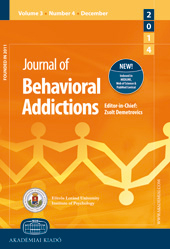Gender Differences in Pathways to Compulsive Buying in Chinese College Students in Hong Kong and Macau
Gender Differences in Pathways to Compulsive Buying in Chinese College Students in Hong Kong and Macau
Author(s): Terence H. W. Ching, Chao Tang, Anise M.S. Wu, Elsie YanSubject(s): Gender Studies, Cognitive Psychology, Behaviorism, Substance abuse and addiction, Socio-Economic Research
Published by: Akadémiai Kiadó
Keywords: compulsive buying; shopping addiction; mood compensation; irrational cognitions; mediation; gender differences;
Summary/Abstract: The addictive nature of compulsive buying implies that mood disturbances, stress, and cognitive biases that underlie compulsive buying might operate in ways similar in both genders. In the current study, we aimed to test hypothetical pathways of mood compensation and irrational cognitions, which may explain compulsive buying tendencies. We also examined potential gender differences in these pathways. Methods: Two hundred and thirty-two male (age: M= 20.30, SD = 1.74) and 373 female Chinese college students (age: M= 19.97, SD = 1.74) in Hong Kong and Macau completed measures assessing compulsive buying, psychological distress, avoidance coping, materialism, and buying-related cognitions. Mediation analyses via a structural equation modeling approach explained by Cheung (2007, 2009) were conducted, with gender as a grouping variable. Results: There was a gender difference in the mood compensation pathway; avoidance coping partially mediated the link between psychological distress and compulsive buying severity in females only. On the other hand, the irrational cognitive pathway, in which irrational buying-related cognitions fully mediated the link between materialism and compulsive buying severity, was supported for both genders. There was no gender difference in the extent of mediation within the irrational cognitive pathway, and the mediation effect within the irrational cognitive pathway was larger than that within the mood compensation pathway for both genders. Conclusions: Mood compensation processes in compulsive buying might be female specific, and secondary to irrational cognitions, which were gender invariant. Gender-dependent mechanisms and irrational cognitions should be emphasized in compulsive buying treatment.
Journal: Journal of Behavioral Addictions
- Issue Year: 5/2016
- Issue No: 2
- Page Range: 342-350
- Page Count: 9
- Language: English

